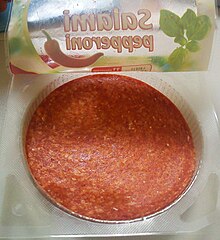Pepperoni

Packaged pepperoni
|
|||||||
| Place of origin | United States | ||||||
|---|---|---|---|---|---|---|---|
| 460 kcal (1926 kJ) | |||||||
|
|||||||
| |
|||||||
| Protein | 20.35 g |
|---|---|
| Fat | 40.2 g |
| Carbohydrate | 4 g |
| Nutritional value per 100 g (3.5 oz) | |
|---|---|
| Energy | 1,940 kJ (460 kcal) |
|
4 g
|
|
|
40.2 g
|
|
|
20.35 g
|
|
|
|
| Percentages are roughly approximated using US recommendations for adults. Source: USDA Nutrient Database |
|
Pepperoni, also known as pepperoni sausage, is an American variety of salami, usually made from cured pork and beef mixed together.
Pepperoni is characteristically soft, slightly smoky, and bright red in color. Thinly sliced pepperoni is a popular pizza topping in American-style pizzerias and is used as filling in the West Virginia pepperoni roll. It is also used to make some varieties of submarine sandwiches.
The term "pepperoni" is a borrowing of peperoni, the plural of peperone, the Italian word for bell pepper. The first use of "pepperoni" to refer to a sausage dates to 1919.
Even if in Italian the word is plural (like the Italian word salami, plural of salame), the English word pepperoni is used as a singular uncountable noun.
In Italian, the word peperoncino (diminutive of peperone) only refers to hot and spicy peppers, or sometimes to small, sweet kinds, while peperoni refers only to sweet peppers, such as bell peppers.
Pepperoni is a cured dry sausage similar to the spicy salamis of southern Italy, such as salsiccia Napoletana piccante, a spicy dry sausage from Naples, or the soppressata from Calabria. The main differences are that pepperoni has a finer grain (akin to salami of Milan, a spiceless regional variant of salami), is usually softer, and is produced with the use of an artificial casing (instead Italian salami are produced using natural gut for casing). Pepperoni is mass-produced to meet the demand for the sausage.
...
Wikipedia
